Carnivorous Plants Story
Picture book for a young audience /
Kindle Edition
by
Makoto Honda
Copyright (c) 2013-2017 by Makoto Honda.
All Rights Reserved.
_______
Sundews (2)
GENUS Drosera









A leaf of a
sundew (Drosera intermedia) with a prey. Note the very active tentacle
bending as well as leaf folding in response to prey capture..











A sundew leaf is covered with fine hairs tipped with a sticky glue. These hairs are called tentacles. A gland at the tentacle tip secretes a crystal-clear mucilage to entrap prey.


Sundew
tentacles (left) tipped with a sticky mucilage (Drosera filiformis), and
a tentacle of a sundew (Drosera intermedia).

A leaf
section of an African sundew (Drosera capensis). The "central tentacles"
are the shortest tentacles in the leaf center. The "marginal tentacles" are the
longest tentacles growing on the leaf margin. Between these two tentacle groups
grow the "outer tentacles."
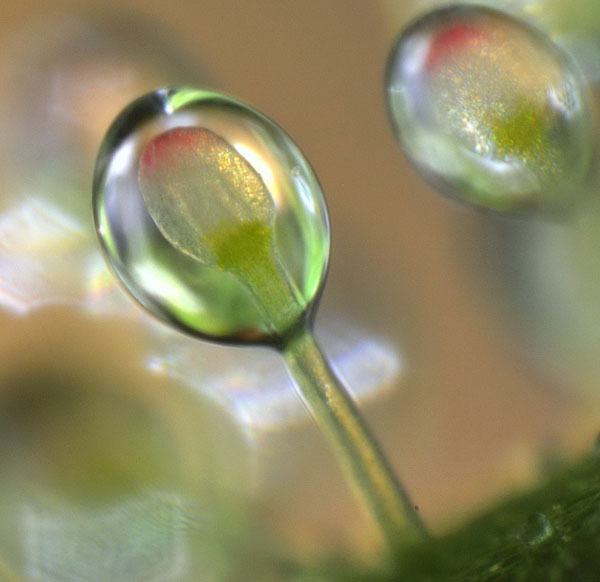
A
crystal-clear droplet of mucilage enveloping the gland at the tip of a slender
stalk of a sundew tentacle (Drosera filiformis).
When an insect lands on a sundew leaf, it immediately becomes mired in the sticky mucilage. As the insect struggles to escape, nearby tentacles also begin to bend toward the prey. Although the movement of the tentacles is rather slow - often taking a few minutes or more to bend over the trapped prey - there is no doubt the flexing tentacles greatly improve the sundew's chance of a successful catch.
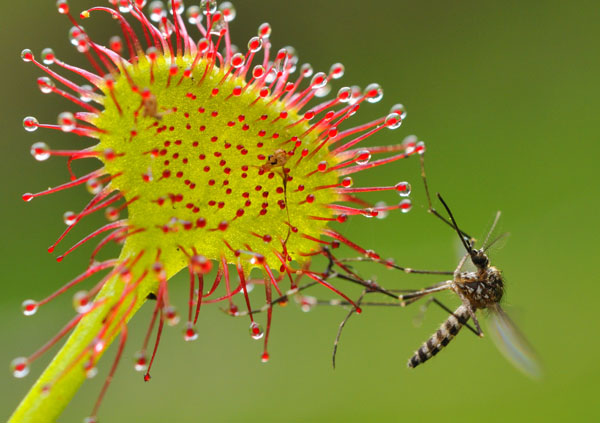
Even the
slightest brush with a glue-holding tentacle leads to a deadly consequence. A
mosquito is being caught by its legs. In May, in northern California.

The most
common, round-leaf sundew (Drosera rotundifolia) securing a meal for the
day, in northern California, in May. Note that many flexing tentacles are
holding the prey firmly in the center of the leaf where the body of the bug is
being digested.
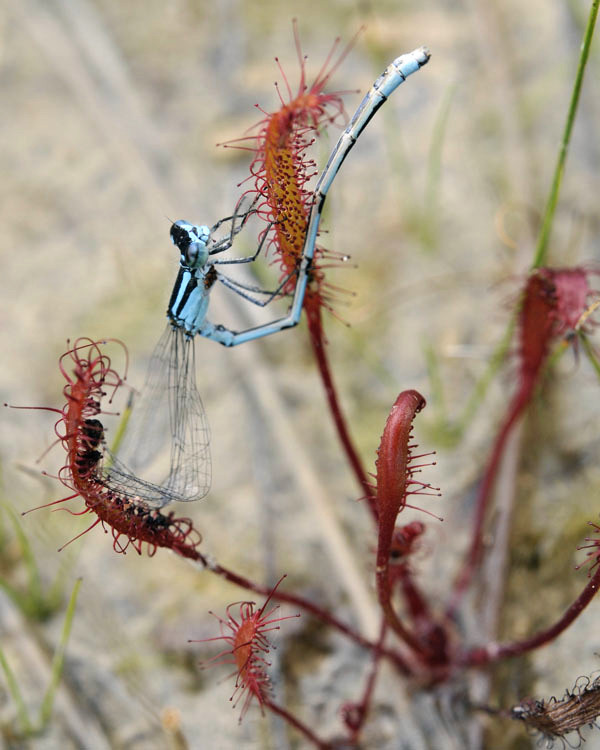
A dragonfly
struggling to free itself from the tenacious hold of a linear-leaved sundew (Drosera
linearis) in a Michigan fen along the shore of Lake Huron. In early July.
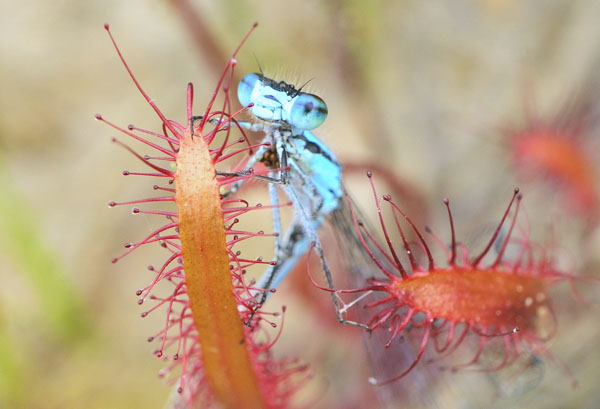
A dragonfly
struggling to free itself from a linear-leaved sundew (Drosera linearis).

A crane fly
falls victim to the powerful grip of a round-leaf sundew (Drosera
rotundifolia), in northern California, in June.
In many sundews, when a large prey is captured, the entire leaf also slowly folds around the prey. This movement of leaves and tentacles brings more glands in contact with the prey. After a few hours, the glands on the tentacle tip begin to produce digestive fluids. As the insect body begins to dissolve, the nutrients are promptly absorbed through the leaf and are carried to other parts of the plant.
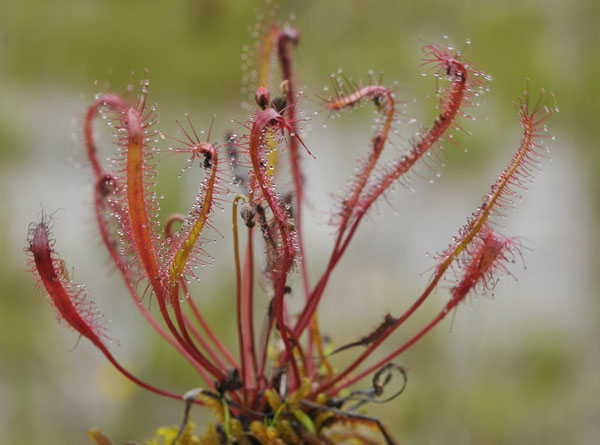
The
linear-leaved sundew, Drosera linearis, showing a voracious appetite for
insect life in a marl fen in northern Michigan, in early July. Note many flexing
leaves capturing small insect prey.
In a typical natural habitat, many sundews grow together, often covering a large area of marshy surface. This is very much to their advantage, because in these situations, insects such as butterflies and dragonflies - that are usually too large for a single sundew to capture - are often successfully contained by the cooperation of many sundews, each grabbing a part of the insect body.
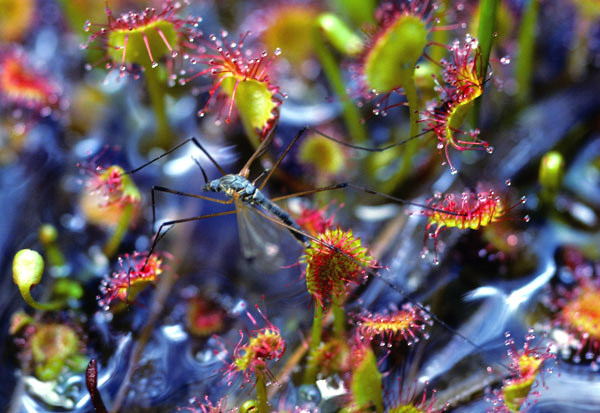
A hapless
crane fly landing on the dense cover of the round-leaf sundew (Drosera
rotundifolia) in northern California. In August.

A sundew (Drosera
intermedia) capturing a small fly.




A sundew (Drosera
intermedia) capturing a small fly. From top-left: 5 minutes after the
capture; 10 minutes; 15 minutes; 20 minutes (lower-right).
In the spring, a slender flower stem appears
in the rosette center. The flowers of sundews are generally small. The flowering
season lasts from spring to the end of summer in U.S. habitats.
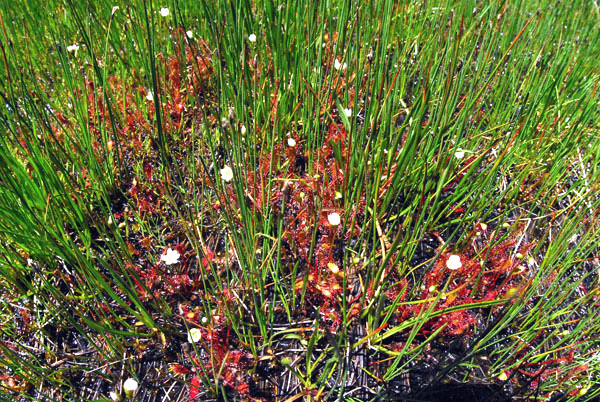
White
flowers bloom amidst the jungle of sticky, glandular hairs. The pollinators must
fly their way very carefully to the flowers. A small navigational error may
spell disaster for the pollinator resulting in dire consequences. In Oregon, in
mid-July.
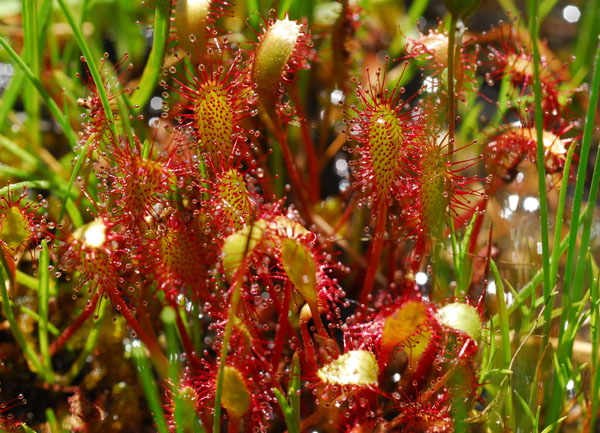
Dew-holding
glandular leaves of the English sundew, Drosera anglica, in Oregon, in
mid-July. Note a bright red color of the tentacles covering the leaf surface.
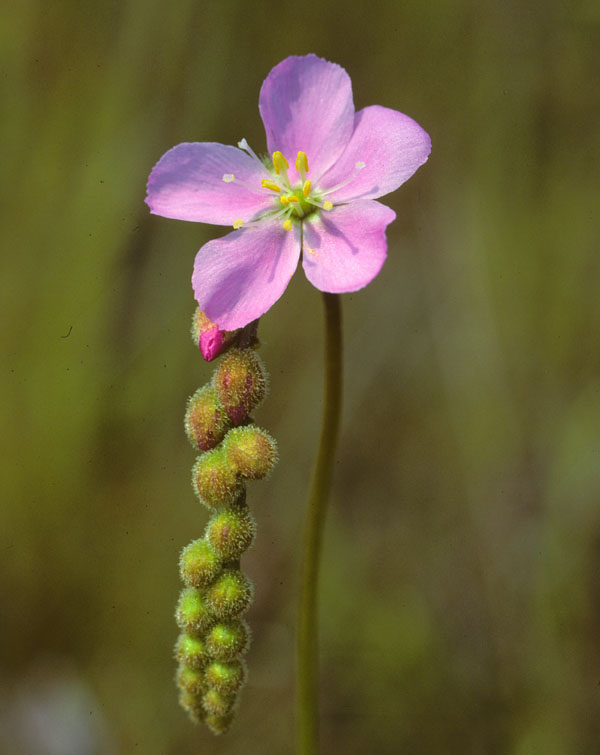
An imposing
flower of the thread-leaf sundew, Drosera filiformis. The large, pink
flower measures up to 4 cm in diameter.

Flowers of
Drosera capillaris plants atop slender flower stalks. The leaves of the
plants are hidden in the surrounding vegetation. In Florida, in May

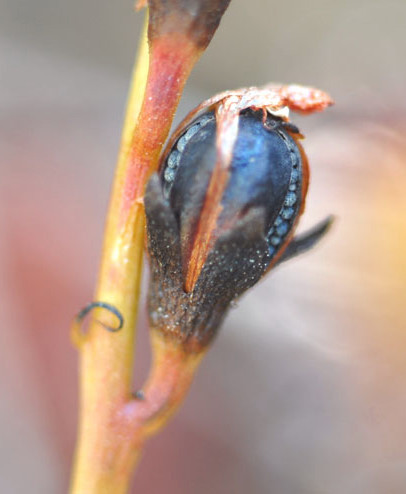
A pink
flower of Drosera capillaris (left) in Florida, in May. A seed capsule on
the flower stalk (right) of a sundew (Drosera intermedia). Note the
numerous black seeds in the dry capsule about to burst. In mid-July, in southern
Michigan.
INTRODUCTION PITFALL TRAPS FLYPAPER TRAPS SNAP-TRAPS SUCTION TRAPS VENUS FLYTRAP SUNDEWS PITCHER PLANTS COBRA PLANT BUTTERWORTS BLADDERWORTS
Carnivorous
Plants Story - Copyrighted Material
Copyright (c) 2013 by Makoto Honda. All Rights Reserved.
Email: mhondax@gmail.com
__________________
For
a young audience, click
here for
"Eaten Alive by Carnivorous Plants" by Kathleen J. Honda & Makoto Honda